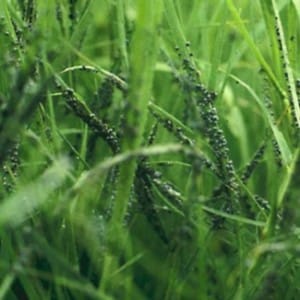 This is a Slime Mold growing on turf.
This is a Slime Mold growing on turf.
This information is taken from the UGA publication, Turfgrass Diseases in Georgia: Identification and Control
Slime molds are caused by the fungi Physarum spp. and Fuligo spp.
All turfgrasses are susceptible to slime molds
 Symptoms: Large numbers of pinhead-sized fruiting bodies may suddenly appear on grass blades and stems in circular to irregular patches 1-30 inches in diameter. Affected patches of grass do not normally die or turn yellow and signs of the fungi usually disappear within 1 to 2 weeks. These fungi normally reproduce in the same location each year. The fungi are not parasitic, but they may shade the individual grass leaves to the extent that leaves may be weakened by inefficient photosynthesis.
Symptoms: Large numbers of pinhead-sized fruiting bodies may suddenly appear on grass blades and stems in circular to irregular patches 1-30 inches in diameter. Affected patches of grass do not normally die or turn yellow and signs of the fungi usually disappear within 1 to 2 weeks. These fungi normally reproduce in the same location each year. The fungi are not parasitic, but they may shade the individual grass leaves to the extent that leaves may be weakened by inefficient photosynthesis.
Conditions favoring Slime Molds: Slime molds are favored by cool temperatures and continuous high humidity. An abundance of thatch favors slime molds by providing food directly in the form of organic matter.
Management:
Remove slime mold by mowing.
Remove using a gardening tool or high pressure stream of water.
For more information on slime molds and other turf diseases, see Turfgrass Diseases in Georgia: Identification and Control
Slime molds elsewhere:

Other slime molds form irregularly shaped ‘blobs’ that grow on mulch, turf or other areas with organic matter. Read more about these in the publication, The Truth about Slime Molds, Spanish Moss, Lichens and Mistletoe
Also find pictures of various slime molds here.
